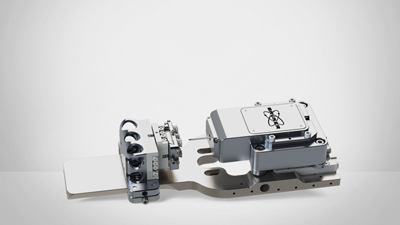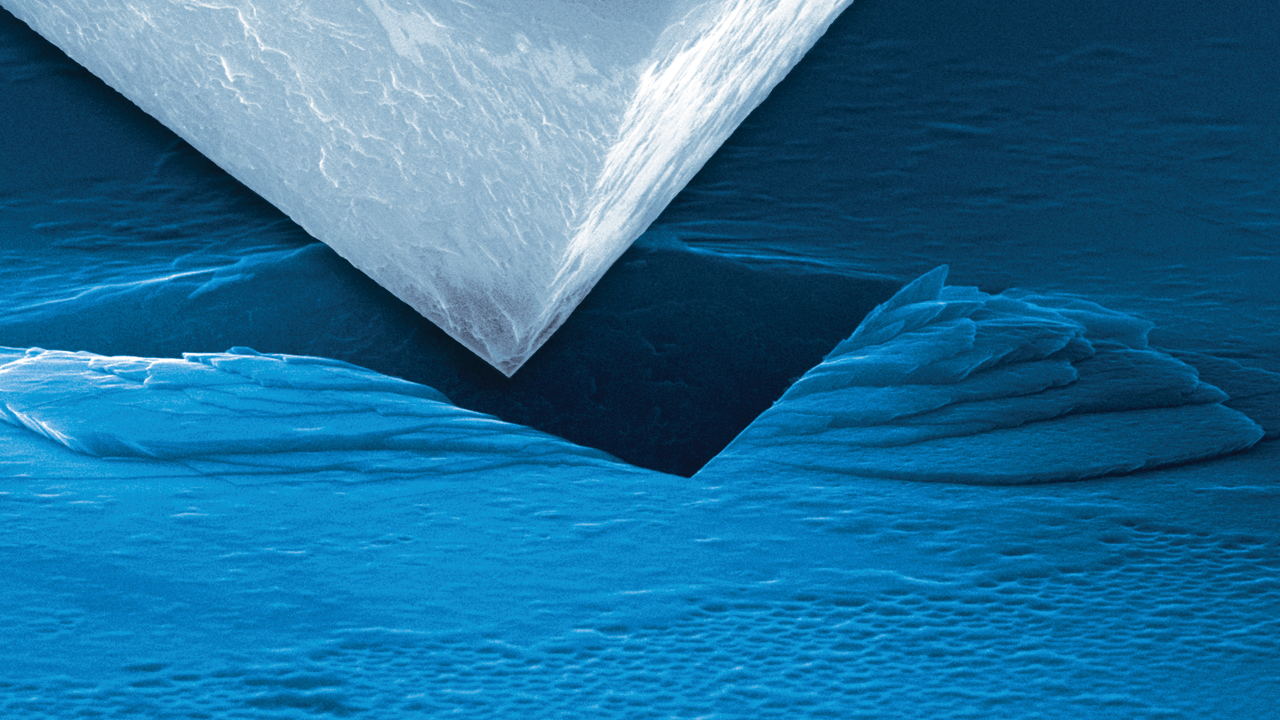Direct Pull Tension Testing with the Hysitron PI 89 SEM PicoIndenter — A Primer
Isolating and Characterizing Mechanical Response from Different Microstructural Regions During Nanotensile Testing
The tensile test is the most ubiquitous method for macroscale mechanical characterization of materials. This is because it provides a full stress strain curve, allowing analysis of such important material properties as yield strength, ultimate strength, elastic limit, and work hardening rates. In situ nanomechanical testing is a powerful family of techniques that allow for real-time observation of deformation mechanisms that are directly correlated to load-displacement data. The combination of these techniques with high-resolution electron microscopy and its related chemical and structural analysis techniques can provide incredibly detailed data. Furthermore, the samples are small enough to enable testing of individual microstructural features, such as single grains, grain boundaries, fusion zones and heat affected zones, and surface treatment zones. This allows these techniques to be highly complementary to traditional bulk scale testing, offering microstructural-level understanding of mechanical behavior.
This application note discusses using the Hysitron PI 89 SEM PicoIndenter and Tribo iQ application for direct pull tension within an SEM application, including the steps required for tip and sample fabrication, tip alignment, and data analysis.
KEYWORDS: Tension Testing; PI 89; SEM PicoIndenter; Stress-Strain Curve; Deformation Mechanisms; Tribo iQ; Direct Pull; FIB Machining; Duplex Steel
Direct Pull vs. Push-to-Pull Testing
Various sample geometries exist, which can produce different stress states, thereby inducing different types of behaviors. Of these, uniaxial tension is often a desirable choice as it provides information on elasticity and yielding like a compression test, but in addition can give comparatively better understanding of the material’s ductility. As a trade-off, more preparation time is needed for tension tests compared to compression tests, whether doing direct pull or push-to-pull (PTP). PTP utilizes a microelectromechanical system (MEMS) device to convert compression into tension,1-2 where a direct pull uses a gripper tip to pull a dogbone specimen.3 Push-to-Pull requires either a micromanipulator or float deposition onto the device but can be run with a conventional flat punch tip, whereas direct pull requires a special gripper tip. Since the springs of the PTP are in parallel with the sample, data correction is needed by subtracting the device stiffness, but this acts to help redirect the force along the tension axis and provide extra stability for delicate specimens. Meanwhile, direct pull is more sensitive to misalignment issues, but allows many samples to be fabricated on one piece and could be ran as a higher-throughput technique.
Experimental Procedure and Results
Next, the lamella is divided up into sections for each of the individual dogbones. Leaving some material between each section blocks redeposition of the sputtered material from landing onto the sample next to the one you are working on. In our example, the lamella was then thinned from the edge-on view, followed by further reduction of the cross-section to a little larger than the maximum width of the dogbone. This cut only extended into the lamella roughly the final sample length. From here, the rough shape of the dogbone sample was cut into this material. This was then refined with even lower current (100pA) cuts and utilizing appropriate over- and under-tilt was utilized to remove tapering; this is especially important for the gripped section where the tip makes contact with the sample. There are a variety of ways to fabricate the geometry of the gripped head. Generally, it needs to be substantially wider than the gauge section of the specimen, at least 3:1. This helps ensure deformation occurs in the gauge.
It also needs to be at least long enough to prevent plastic bending of the ends upwards relative to the center. The transition from the gauge section to the gripped region can be done with an angle or as a sharp 90° transition. The sharp transition is simpler to cut, and to match between the tip and the sample, but it has a couple of disadvantages. One is that the stress concentration at the transition point from the gauge to the head will be higher than the angled transition, which will affect nucleation of fracture and plasticity. Secondly, the angled contact allows the sample to self-align to the tip more easily in the case of slight misorientations. This is because the angled contact can produce a lateral force to help center the sample in the gripper. The flat geometry, comparatively, will contact on one side of the sample first, then either this side of the gripped region will deflect, allowing for the second contact to be made, or more likely, the gripped region will rotate into contact.
The tip also needs to be carefully fabricated by FIB machining. Essentially, the negative image of the dogbone head needs to be fabricated at the end of the gripper tip, but slightly oversized. This allows room for maneuvering the tip into position around the sample. To do this, a 60° conical tip was the starting point. Other starting tip shapes could be chosen, but this one allows the required shape to be formed with minimal required removal of material. It will also have a gradually increasing diameter, and therefore width and thickness, so that the tip can have good clearance to reach the samples, which will be slightly inset with regards to the original bulk material.
The first step in the cutting is flattening the end of the cone. As can be seen in Figure 2, the initial cuts for shaping the tip has some overlaid markings from the software measurement tool to help visualize the final shape of the gripper and judge how far back to cut. It’s also important to leave several microns of material on the grips to ensure that it is reasonably robust. Next, the gripper tip is thinned; usually the tip should be twice as thick as the sample to facilitate sample alignment without being overly large and potentially interfering with the surrounding material. This could be done with an end-on view of the tip, or from the side as done here. Once the tip is thinned, the majority of the material has then been removed, and shaping of the gripper region can begin with reduced beam current. Cutting a hole through material with a FIB results in a lot of redeposition, so it is preferable to start by boring a hole much smaller than the final shape with high current, as shown. This can then be gradually opened up by cutting away at the sides. The final shaping is done again with a low beam current and utilizing appropriate tilt into the surface being cut to prevent tapering. For diamond, 2° works well.
With the tip and samples prepared, the actual experiments can be conducted. For alignment of the tip to the sample, first the tip should be brought over the top or bottom of the sample. This is done by ensuring the focal plane is different for the tip and samples, then maneuvering the tip into position in the other axes. Then, the tip can be lowered/ raised to the same Z height as the dogbone sample. The focus can be a good indicator of the height difference, but since electron beams have a large depth of focus, the final steps of alignment can be more challenging. The best indicator when they are close together in height is shadowing, which is caused by the nearby surface partially blocking the escape of secondary electrons. This is shown in Figure 3, where in (b) the focus is close but no shadow is observed, whereas in (c) there is a visible shadow on the right side. It is also possible to gently touch the tip and sample together if no pre-deformation is applied, and use the force reading as an indication of being well aligned.
Results and Analysis
An example experiment is also shown, with a load-displacement curve and correlated video frames. Initial elastic loading gives a linear slope to the fist point. A large load drop occurs, then the load continues to increase with a large slope versus displacement. Since this is a duplex steel, this load drop could either be correlated to a phase transformation of the austenitic material to martensitic, or to the nucleation of an initial slip step that requires additional force to become fully activated. In the latter case, there would likely be some obstacle to dislocation motion in the interior of the specimen, such as a grain boundary.
Eventually, after a second large load drop, more homogenous plasticity is observed, which is correlated to a series of smaller load drops associated with the motion of small bursts of dislocations and/or nucleation of additional parallel slip bands. Necking can be observed in the SEM image. Eventually, the sample fails in an abrupt manner, with a large load drop. The residual fracture surface resembles that of a cup-and-cone fracture, which is typical for a ductile material. In our example, the necking did not continue for very long prior to fracture, indicating the material is giving an overall mixed ductile-brittle response.
The range of transducers available allow the method presented here to be applied to samples of various sizes and compositions. For reference, the corresponding maximum tensile load for specific transducers is given in Table 1.
To perform data analysis, the Tribo iQ analysis application can be utilized. This is designed to allow rapid creation of individual analysis applications suited to specific experiments. In this case, the tension analysis app allows data to be loaded, grouped, and graphed in a variety of ways. Essential data manipulation procedures, such as re-zeroing and machine compliance corrections, can be quickly and easily applied. Both engineering and true stresses and strains can be calculated by inputting the sample geometry, and the yield strength/modulus can be fit using an offset strain. Lastly, the stress-strain curves can be compared between multiple samples (as shown here for three different dogbone samples). The stress-strain curve can also be plotted alongside the video to produce side-by-side stress-strain videos.
Conclusion
Direct pull tension testing in situ SEM is a powerful technique for isolating and characterizing the mechanical response of different microstructural regions of a material. Accompanying electron microscopy gives detailed insights into the prevalent deformation mechanisms and can elucidate structure-property relationships. The sample and tip preparation routes via focused ion beam machining were shown in detail, along with tip/sample alignment, testing and data analysis. Bruker's Hysitron PI 89 with Tribo iQ has applications designed to easily calculate stress and strain, while also easily comparing data and making side-by-side videos with mechanical data.
References
- Chisholm, C., Bei, H., Lowry, M.B., Oh, J., Asif, S.S., Warren, O.L., Shan, Z.W., George, E.P. and Minor, A.M., 2012. Dislocation starvation and exhaustion hardening in Mo alloy nanofibers. Acta Materialia, 60(5), pp.2258- 2264.
- Bruker Push-to-Pull Device patents are US: 8434370; 8789425 and Europe: 2349913.
- Kiener, D. and Minor, A.M., 2011. Source truncation and exhaustion: insights from quantitative in situ TEM tensile testing. Nano letters, 11(9), pp.3816-3820.
- Moser, G., Felber, H., Rashkova, B., Imrich, P.J., Kirchlechner, C., Grosinger, W., Motz, C., Dehm, G. and Kiener, D., 2012. Sample preparation by metallography and focused ion beam for nanomechanical testing. Practical Metallography, 49(6), pp.343-355.
Authors
Eric Hintsala, Bruker Nano Surfaces and Metrology Division (eric.hintsala@bruker.com)
©2021 Bruker Corporation. Hysitron, PicoIndenter, and Tribo iQ are trademarks of Bruker Corporation. All other trademarks are the property of their respective companies. All rights reserved. AN1541, Rev. A0.


